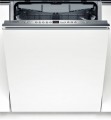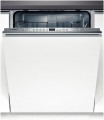Number of place settings
The maximum number of dish sets that can be loaded into the dishwasher at one time. A set is considered a set of dishes for one person: four plates (for the first course, for the second course, salad, bread), a plate for dessert, a cup, a spoon and a fork.
The large capacity allows you to wash numerous dishes in the device at one time without starting the washing programme again. At the same time, excess capacity is just as undesirable as insufficient. Firstly,
a capacious operating chamber affects the dimensions of the entire device. Secondly, such units consume more water. Thirdly, if there is not much dirty dishes, you either have to wait until it accumulates, or start an underloaded device, wasting water and detergents. Therefore, when choosing according to this indicator, real needs must be taken into account and not chase after the maximum capacity.
Water consumption
The amount of water used by the dishwasher in one washing cycle. Usually, it is indicated for a standard cycle — at full load, without pre-rinsing, etc. Accordingly, in special modes, the consumption may differ from the indicated one.
The lower the consumption — it better; this is especially true for those who consume water by metres or who have a limited supply of water (for example, it is drawn from a well with a low productivity). On the other hand, a reduction in consumption can have a negative effect on the quality of the wash. So, choosing an
economical dishwasher, you should pay attention to the washing class (see below). In addition, only models of the same capacity can be compared in terms of consumption — after all, the more dishes, the more water is required to wash them.
Dryer type
The dishwasher has a drying function. Drying can occur both due to the natural evaporation of water from the surface of the dishes (
condensation drying), and due to its
blowing with heated air; the first option is more economical, since it does not require energy and there is also an improved one —
with a heat exchanger; the second, in turn, provides faster drying. The recently introduced new type of
Zeolith drying combines two methods, as it first collects residual moisture and then converts it into heat, which dries the dishes and belongs to premium segment models. Note that not all dishwashers are capable of drying dishes to dryness; see drying class for details.
Cutlery tray
Separate
cutlery tray for loading (spoons, forks, knives, etc.) into the dishwasher. Such a device is more convenient than a common basket: it allows you to load cutlery separately from the rest of the dishes, while the contents of the tray are compactly located in the “seats” specially designed for this. And the quality of washing is often higher than when using a common basket.
Inverter motor
The presence of
an inverter motor in the design of the dishwasher.
Inverter motors are brushless and have higher efficiency, lower noise levels, and improved safety due to the absence of brushes. However, they are more expensive compared to conventional motors.
Hot water supply
Possibility of connection of the dishwasher to a source of hot water. With this connection, the water enters the device already heated (unlike the usual procedure, when the dishwasher itself heats the water to the desired temperature) — thus it saves time and energy. However, note that
"hot connection" is demanding on the quality of water: in most cases, it must have a temperature of 60-65 °C and be supplied without pressure drops.
Note that hot water connection is an option, not the only way; dishwashers with the possibility of such a connection can usually work according to the standard scheme, from a source of cold water.
Door closer
The presence of an
door closer in the design of the dishwasher.
An auto-closer is a device that helps close or open a door smoothly to the fully closed or open position, preventing the door from remaining in an intermediate position. It has two functions: ensuring the door is fully closed to prevent splashes and damage, and providing soft closing/opening to prevent shock and damage.
Dimensions (HxWxD)
Dishwasher dimensions in height, width and depth. An obvious parameter; we only note that when determining the amount of space required for integration, the width and height of the unit are important.
In most modern built-in dishwashers, the width corresponds to one of the standard values (about a centimeter):
45 cm for narrow models,
60 cm for standard ones and
55 cm as a compromise between these dimensions. As for the second dimension, dishwashers with a height of up to 60 cm inclusive are usually classified as
compact, they require installation at a certain height above the floor.
Full-size models, with a height of more than 60 cm, can also be installed at floor level.

